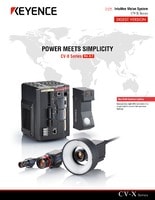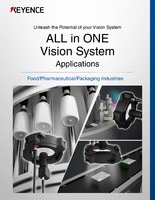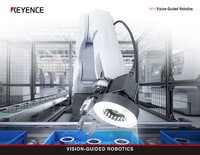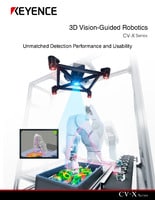Quiz 1
Q01Which is the correct way to get the maximum depth of field?
- Fully close the lens aperture.
- Fully open the lens aperture.
Correct answer:A.Fully close the lens aperture.
The conditions for a larger depth of field are:
- A lens with a shorter focal distance
- A larger working distance
- A narrower aperture.
If you need a greater depth of field, check whether the conditions above are applicable.
Q02What is the FOV (field of view) in the Y direction of a macro lens with a 3x-optical magnification attached to a camera with a CCD size of 3.6 (0.14") mm in the Y direction?
- 1.2 mm (0.047")
- 10.8 mm (0.43")
Correct answer:A.1.2 mm (0.047")
The field of view when using a macro lens can be calculated with the following formula:
CCD size (Y) / optical magnification (3.6 (0.14")/ 3 = 1.2 mm (0.047").
Q03Which lens is faster, a lens with an f-number of 1.4 or 2.0?
- F-number of 1.4
- F-number of 2.0
Correct answer:A.F-number of 1.4
An F-number (F No) is a value to indicate the light-gathering ability of a lens.
The faster a lens is, the smaller the F-number.
Q04What type of illumination is effective for highlighting flaws on a flat surface?
- Coaxial illumination
- Low-angle illumination
Correct answer:B.Low-angle illumination
Low angle lighting emits light onto the surface that will reflect the emitted light at the same angle back to the camera. Therefore, a camera mounted directly over the top of the target receives a diffuse reflection from the flaws on the surface, causing them to appear as a different shade then the rest of the target surface.

Flaw
Q05Is the lifespan of an LED light extended by flashing the LEDs during operation?
- Yes
- No
Correct answer:A.Yes
LED light sources generally have a long lifespan and stable switching characteristics. Since overheating is a major cause of reduced lifespans of LEDs, it is advisable to strobe the LED illumination unit in order to dissipate between each inspection.
Q06Which filter is the best choice for inspecting targets through glossy film?
- Dark filter
- Polarizing filter
Correct answer:B.Polarizing filter
A dark filter simply reduces the amount of light received. This does not have a positive effect for inspections through plastic film. On the other hand, polarizing filters reduce glare by lining up the direction of light from the illumination source and the lens. The example images to the right show that the image of an electronic component through film is more clearly captured.

Q07Which of the following illumination types is the best choice to emit light evenly on the glossy surface of a spherical-shaped target?
- Direct illumination
- Indirect illumination
Correct answer:B.Indirect illumination
When light is emitted directly on the glossy cylindrical-shaped target, the light is reflected irregularly as shown in the left image. On the other hand, when light is indirectly emitted, an evenly lit image can be captured as shown in the right image.

Q08What is the resolution of an image with a 48 mm (1.89") FOV captured on a CCD that is 640 pixels wide by 480 pixels long?
- 0.1 mm (0.004")
- 0.075 mm (0.003")
Correct answer:A.0.1 mm (0.004")
Resolution refers to a value indicating how many mm a pixel represents when capturing an image in a certain FOV. This value can be obtained using the following formula: = FOV (mm) / the number of pixels.
The resolution is 0.1 mm (0.004"), 48 mm (1.89")/ 480 pixels.
Q09What is the resolution of an image with a 5-mm (0.2") FOV captured on a CCD that is 2000 pixels in length?
- 2.5 μm (0.1 mil)
- 10 μm (0.39 mil)
Correct answer:A.2.5 μm (0.1 mil)
Based on the formula in Question 11, it is 5 mm (0.2") / 2000 pixels = 0.0025 mm (0.0001") = 2.5 μm (0.1 mil)
Q10What is the maximum line speed that is possible with a 100-mm (3.94") FOV at a 10-ms processing time?
- 100 m (328.1’)/min.
- 600 m (1969’)/min.
Correct answer:B.600 m (1969’)/min.
The fastest speed of a production line (the fastest speed at which an inspection can be performed) is determined by the necessary area to be measured (100 mm in this example). In order to cover the FOV of 100 mm (3.94") at the processing speed of 10 ms, the highest speed of the production line (min.) can be obtained from the following formula:100 mm (3.94")/ 0.01 sec. × 60 sec. = 600,000 mm (23,640") 600 m (1970’)
Q11What is the minimum shutter speed that can be used to keep an image from blurring under 0.1 mm (0.004") when the target is moving at 1000 mm (39.37")/sec.?
- 1/1000 sec.
- 1/10000 sec.
Correct answer:B.1/10000 sec.
In order to determine the fastest shutter speed (the exposure time required to capture the target), it is necessary to know the acceptable amount of blur (0.1 mm in this example) and the production line speed (1000 mm/sec. in this example).
Minimum shutter speed = 0.1 mm (0.004") / 1000 mm (39.37") = 1/10000 sec.
Q12What is the generic name for an algorithm that searches for targets based on profile information?
- Geometry search
- Normalized correlation search
Correct answer:A.Geometry search
This is generally called geometry search or profile shape search. Geometry search searches for targets based on profile information. Even if a part of the target is missing, it allows accurate search by using the remaining information. As a result, it has become a mainstream of search processing in recent years. Normalized correlation search has been used for a long time. Although it may be affected when a part of the target is missing, it is the most commonly used method because it allows accurate search without being affected by variations in ambient brightness.
Q13Which preprocessing filter is effective for removing fine black noise on targets with a white background?
- Expansion filter
- Shrink filter
Correct answer:A.Expansion filter
By using the Expansion filter, the intensity of the center of a 3 × 3 area is replaced with the maximum intensity among those 9 pixels including the center pixel. As a result, the pixels with lower intensity (fine black noise) are replaced with the value of the surrounding higher intensity pixels. In contrast, the Shrink filter replaces the intensity of the center pixel with the minimum intensity (the darkest value).
Q14What phenomenon occurs when the corners of the FOV are darkened when a lens is not appropriate for the CCD size?
- Smear
- Mechanical vignetting
Correct answer:B.Mechanical vignetting
Mechanical vignetting is a phenomenon that occurs when the lens is too small for the camera’s CCD. Recent high-resolution cameras tend to have large CCD elements, which makes it necessary to confirm the appropriate size of the lens used in advance.
Q15What function does OCV perform in regard to machine vision?
- Checks whether printed characters correspond with the originally intended content.
- Reads printed characters and outputs the information for sorting, verification, or automatic control.
Correct answer:A.Checks whether printed characters correspond with the originally intended content.
With OCV, the correct character strings are programmed in advance, and verification is performed on images captured by the machine vision system. OCV is commonly used for inspections of expiration dates. OCR reads marked characters and then outputs to external devices for classification, verification, and other control processes.
Q16What is the smallest size foreign particle that a 5-million pixel camera can detect?
- 50 μm (1.97 mil)
- 0.2 mm (0.008")
- Dependant on the FOV
Correct answer:C.Dependant on the FOV
The minimum detectable object is determined by two factors, the X-Y range needed to be measured by the camera (the FOV) and the number of pixels of the camera to be used. It can be derived with the following formula: the Y-direction of the FOV (mm) / the number of pixels the CCD has in the Y direction.
Q17Which of the following is the most important element for stabilizing machine vision inspections in almost all applications?
- Processing speed
- Illumination
- High-resolution
Correct answer:B.Illumination
There are some situations where A and C are just as important as illumination. However, without the proper illumination, inspections cannot be stably performed with machine vision. Recent advancements in pre-processing filters have aided in stabilizing inspections when lighting is not 100% repeatable, but choosing the correct light source is still the most important.




![A Technical History of Image Processing Vol.1 [Camera]](/img/asset/AS_46814_L.jpg)
![The Latest Image Processing Applications [Transportation Industry]](/img/asset/AS_71759_L.jpg)

![The Latest Machine Vision Inspections [Food and Medical Industries]](/img/asset/AS_72814_L.jpg)








